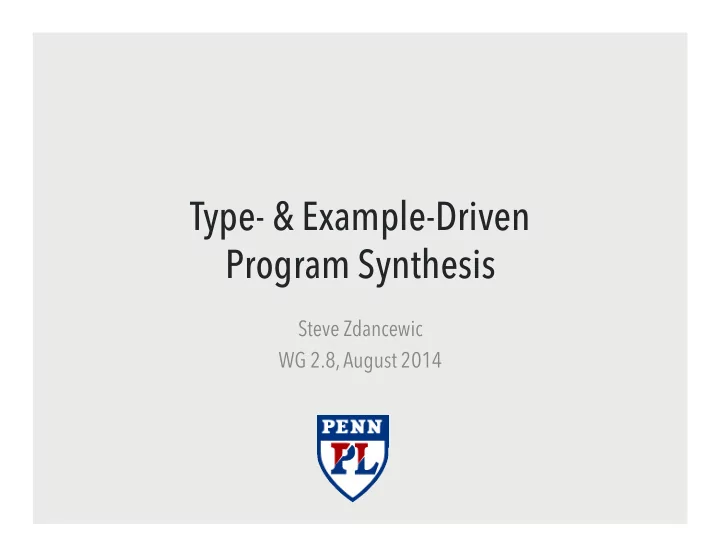

Type- & Example-Driven Program Synthesis Steve Zdancewic WG 2.8, August 2014
• Joint work with Peter-Michael Osera
CAVEATS • Work in progress – Similar work been done before – This is our attempt to understand some of the basic issues, maybe make some advances • We have: – Some theory that describes our approach – A couple of (incompatible, likely buggy) implementations – Implementations that don’t (yet) agree with all of our theory • Feedback welcome! – Connections to things like Quickcheck, Agda, …? – Suggestions for application domains
Background: Program Synthesis • Recent Highlights: – Gulwani et al. (Spreadsheets, …) – Solar-Lazama et al. (Program Sketching) – Torlak (Rosette,…) • ExCAPE – Robotics control (synthesize plans) – Cache coherence protocols – Education (synthesize feedback based on buggy student code) – … • Syntax-guided Synthesis (SyGus) competition – Surprisingly effective “brute force” enumeration of program snippets by syntax
Inductive Program Synthesis • Summary: Use proof search to generate programs • Old idea: 1960’s, 70’s, 80’s – Application of theorem proving to problem solving. [Green 1969] – Synthesis: Dreams → Programs. [Manna & Waldinger 1979] – A deductive approach to program synthesis. [Manna & Waldinger 1980] • More modern incarnations: – Haskell’s Djinn [Augustsson 2008] – Escher [Albarghouthi, Gulwani, Kincaid 2013] – Synthesis modulo recursive functions [Kuncak et al. 2013] • Good recent survey – Inductive programming: A survey of program synthesis techniques . [Kitzelmann 2010]
DEMO DEMO
Our Approach • Apply ideas from intuitionistic theorem proving – Treat programs as proof terms – Search only for normal forms, not arbitrary terms – Use substructural logic (relevance) • Use concrete examples as a partial specification • Search for terms in order of the size of their ASTs • Intuition / Hope: – Simple (i.e. small), well-typed programs that satisfy a few well-chosen tests are likely to be correct. • Start simple
(Hopeless?) Ideal Goals • Completeness – Enumerate in order of size all distinct programs that do not contradict the examples • Soundness – Synthesized programs are well-typed – Synthesized programs should agree with the examples
(Realizable?) Goals • Completeness – Enumerate in order of size (a prefix of) all programs that do not contradict the examples (after a “reasonable” amount of observation time) – May enumerate non-distinct (i.e. contextually equivalent) programs. • Soundness – Synthesized programs are well-typed – Synthesized programs (if they terminate in a “reasonable” time) should agree with the examples
Simplifications (For Now) • Pure (except for divergence), functional programs • Simple, algebraic types and higher-order functions only – No polymorphism (though this would strongly constrain search) – Monomorphic programs are still interesting • Specification via examples, not logical properties – Good starting point – Probably not sufficient in the long run • Future work: relax these simplifications
(Simple) Target Language • Recursive, algebraic datatypes • Arbitrary recursion • Standard (monomorphic) type system
Proof System for Normal Forms • Factor terms into intro and elim forms: • Inference rules enforce the separation:
Strategies for Enumeration • Representation: – hash-consed locally nameless (closed = Debruijn) – terms keep track of their free variables (makes closing/substitution faster) • Memoize the generation functions • Relevance logic: – Fix and match introduce new variable bindings to the context: G, x:u ⊢ E : t – Memoization won’t work (the context changes) – Split the judgment into two parts • General rule that uses context arbitrarily • A “relevance” rule that requires a particular variable to be used at least once • Original rule recovered by: G, x:u ⊢ E : t = G ⊢ E : t + G, <x:u> ⊢ E:
Strategies for Pruning • Eliminate “redundant” matches: • Prune matches with redundant branches: • Question: How much impact does moving from lambda to fix have?
(Super) Exponential Growth 35M ¡ # closed normal terms of type nat -> nat 1M ¡ 32768 ¡ 1024 ¡ 32 ¡ 16 ¡ 8 ¡ 4 ¡ 2 ¡ 1 ¡ #nodes in AST
Pushing Examples Around • Extend the language grammar with examples – Examples are first-class values – They can be given types – At function type, consist of input/output pairs: • “math” notation: X, ex ::= { ・ v 1 v 2 v 3 = v, ・ u 1 u 2 u 3 = u, …} e.g. { ・ sum 0 [] = 0, ・ sum 0 [1] = 1, …, }
Adding Examples to Typechecking Synthesis contexts Old: Constructors without examples New: Constructors with examples
Pushing Examples Through Functions Old: Functions without examples New: Functions with examples
Examples through Elim Forms New: Compatibility requirement – application must respect the provided examples.
Compatibility • Evaluator: an abstract interpreter for the nonstandard language • + approximation to equivalence. • See inference rules.
Heuristics • May compromise completeness, but can greatly reduce search space. • Maximum number of evaluation steps for compatibility checking. – Prevents infinite loops – May miss correct programs • Size restrictions • Limit recursion to “well-behaved” subsets: – e.g. structural recursion • For the demo: Stop at first “good” program
Conclusions / Future • Program synthesis is experiencing a resurgence. – Some old ideas are new again • Fun to think about automatic program generation. – Many limitations too: sensitivity to particular examples • Future work: – Experiments: • i.e. can’t yet measure impact of “example pushing” on size of search space – Think about richer ways to “push” example information through the search. • might require “negative” constraints – Thing about richer specifications • something like Quickcheck properties • suites of related functions – Polymorphism? Dependency? – Interactivity? – Connect to other kinds of work (e.g. SMT-solver based approaches)
Recommend
More recommend